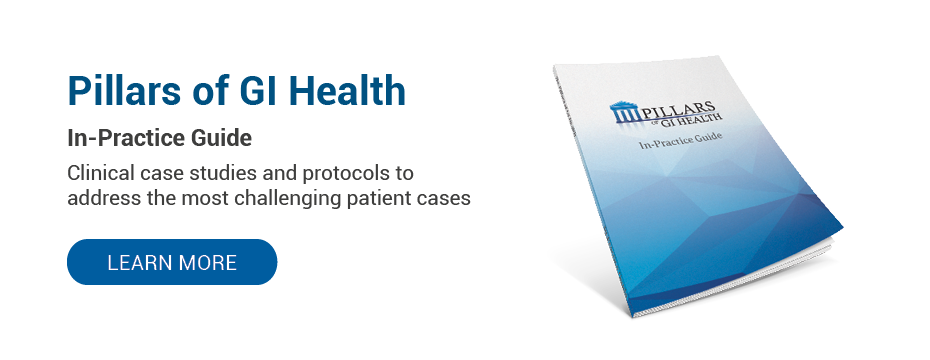You have a new patient coming in to see you. As you peruse her intake forms, you see she has already been treated for small intestinal bacterial overgrowth (or SIBO, for short) several times, and she comes in complaining of recurring symptoms. As you prepare to see her, you feel a rivulet of sweat down your back, knowing this is going to be a tough case. What is the most effective strategy for a patient like this?
In this blog post, we’ll use this sample case study to examine the challenges and pitfalls of diagnosing and successfully treating SIBO.
When SIBO was finally brought to the limelight as a common diagnosis in the early 2000s, it was touted as the missing underlying cause for IBS (irritable bowel syndrome), purportedly responsible for up to 60% of the cases. Once again, we could create a “magic bullet” for patients with IBS by giving them a course of antibiotics that would once and for all wipe out their symptoms. According to Lindsey Drake, MS and Tom Guilliams, PhD, “Historically, SIBO had been described in connection with malabsorption syndromes related to anatomical dysfunction of the GI tract, such as in blind loop syndrome, or in cases of anatomical dysfunction following GI surgery (e.g., gastric bypass).” 1
As we later learned through research, it wasn’t quite so simple. However, the number of cases of SIBO suddenly skyrocketed as breath testing became the commonly used standard to define SIBO cases, while the gold standard–a small intestine aspirate–was too costly and invasive to be practical. Yet, how do we reconcile the two, since often the results of breath testing do not always correspond with the results of a jejunal aspirate? And is SIBO really a diagnosis, or just a symptom of another underlying pathology? I will argue that SIBO is actually just a symptom of a broader range of problems that, when left unaddressed, allow for the recurrence of SIBO in the same patient, which is what often happens.
Case Study
My patient, Joanne, was a 41-year-old female with hypothyroidism following radioactive iodine ablation, who scored a 58 on the Medical Symptom Questionnaire, which indicated moderate toxicity. Her other symptoms included water retention, inability to concentrate, mental fog, chronic fatigue, poor memory, severe bloating, mostly constipation, with occasional diarrhea, muscular weakness, and high levels of anxiety. On further questioning, she admitted her energy improves around 6:30-7 p.m., at which time she gets a “second wind,” but then she doesn’t go to bed until 1 or 2 a.m. She wakes up around 9:30-10 a.m. feeling groggy.
She had been diagnosed with SIBO three years prior to her first visit, at which point she had been treated with Rifaximin with only a brief improvement. As is often the case in disease-focused medicine, her symptoms returned within a few weeks of completing the antibiotic course. The bloating was so severe that at times she felt sick to her stomach. She was at a loss as to what to eat to reduce her symptoms and had honestly lost faith in the medical establishment.
Her diet was vegetarian, but not vegan. She started her day with a cup of coffee with a splash of whole milk. Her protein shake breakfast was consumed on-the-go as she commuted to work. She tended to skip lunch, because she was usually bloated and not very hungry; instead, she had only raw green juice. She didn’t snack between meals. Dinner was usually a quinoa or brown rice bowl with vegetables stir-fried in coconut oil. On occasion, she ate tacos with chickpeas. Before she became vegetarian, she was eating a lot of chicken and turkey. She tended to avoid wheat and gluten, but would cheat with an occasional pasta dish.
Despite her fatigue, she worked out with ferocity. She saw a personal trainer three to four times per week; other days she tried to get in some cardio. Rarely, she made it to a yoga class. Her motivation was losing weight at all costs. Besides the protein powder, she took a probiotic, turmeric, and digestive enzymes when she remembered. She worked a high-stress job, which she didn’t like. Aside from feeling frustrated and concerned about her unresolved health issues, her job was the source of most of her anxiety. Just the thought of having to go into the office and deal with her boss gave her a knot in her stomach. Luckily, it afforded her the freedom to work from home or remotely with clients. She wanted to quit, but this well-paid position afforded her and her husband the lifestyle they enjoyed.
The SIBO Pattern
Are you starting to see a pattern here? Stress, stress, and more stress. Work stress. Pressure to lose weight. HPA axis reversal with difficulty falling asleep, then difficulty waking up in the morning. And lack of self-care, despite a perhaps too-vigorous exercise program. When approaching any SIBO case, you need to think of the upstream problems that may have triggered or perpetuated the SIBO.
As you evaluate SIBO cases, you may start to notice a pattern of stress preceding or fueling the GI disturbance. Often, SIBO patients run in “fight-or-flight” mode all the time. Stress is both a trigger and a mediator of their symptoms. However, what is often forgotten is how stress affects vagal tone, diminishing it and resulting in poor digestive function, low stomach acid, inadequate digestive enzyme secretion, and reduced peristalsis—basically, a set-up for SIBO. The other common inciting event I have seen in SIBO cases is a course of prolonged PPI therapy for GERD, usually three to six months, that is not phased out once symptoms improve.
Sample SIBO Treatment Plan (Part 1)
- Consistency: The first goal with Joanne was to put her on a more consistent routine, reduce stress, and focus on sleep hygiene.
- Stress management: We reviewed the connection between her high stress and lifestyle factors with her current ongoing symptoms.
- GI education: She was given the Pillars of GI Health Patient Handbook to read, and she was educated on the difficulties of treating SIBO with the conventional Western model.
- Diet: The patient was placed on a low-sugar, SIBO-specific diet.
- Mindfulness: We discussed incorporating mindfulness into her life, taking time to slow down and eat her meals with intention, not on-the-go. We talked about making it to a restorative yoga class at least once weekly, and beginning a daily meditation routine through a downloadable app.
- Sleep hygiene: Bedtime was moved to 10:30/11 p.m., with wake-up between 7-8 a.m.
- Supplements: Digestive enzyme support is key, especially betaine HCl! We avoided traditional probiotics, because they can worsen symptoms at the outset.
SIBO (Lactulose) Breath Test
Because the patient suffered mostly from constipation, and bloating could start and last for hours after a meal, the lactulose hydrogen/methane breath test was chosen. It revealed a huge hydrogen spike of 114ppm H2S at 120 minutes. Methane did not spike but was moderately elevated to begin with.
SIBO Treatment Plan (Part 2)
- She was started on Rifaximin again at 550 mg TID for 14 days, accompanied by slippery elm bark, a prebiotic fiber to help shuttle the antibiotic into the problematic bacteria.
- The regimen was complemented by an antimicrobial protocol for the underlying dysbiosis, along with an herbal antifungal for the probable and inevitable yeast overgrowth from the antibiotic.
Post-Antimicrobial Therapy
- The patient reported noticeable improvements in both energy and mental clarity.
- She was less bloated in the morning when she woke up and felt less abdominal pressure throughout the day.
- Her mood was improved, and she was waking up feeling more mentally clear without an alarm.
- She has noticed more stamina with her workouts, and she was now hopeful the plan could work.
Post-SIBO Care
As well as the patient had done at that point, she could easily backtrack due to her high-stress job. In these types of patients, it is imperative to continue to emphasize the importance of mindfulness and stress-reducing techniques as part of their recovery. Patients often feel very dedicated to the concrete aspects of their care—diet, supplements, and exercise—but don’t see meditation and relaxation as equal to those other interventions. It is our duty as functional medicine practitioners to help patients understand the importance of these intangibles in their journey back to wellness.
Conclusion
This case represents the challenges inherent in treating patients with SIBO. The first challenge with any patient accustomed to the Western approach is to explain that there are no magic bullets. The old model of one infection/one antibiotic treatment protocol is outdated. Although Rifaximin may provide temporary relief, a relapse occurs in most cases, unless all the other factors referenced above are addressed. Furthermore, patients with SIBO are most often presenting with complex multi-system issues that require more than a single-solution approach. For any patient presenting with multiple, chronic complaints, like this one, a comprehensive lifestyle intervention approach is the most successful. Remember: Successful SIBO treatment is ultimately about treating the underlying cause. Don’t get fixated in eradicating SIBO and lose sight of the patient as a whole.
Addendum
When choosing treatment options in SIBO patients, consider these points:
- Possibility of background SIFO (small intestinal fungal overgrowth)
- If no SIFO to start, fungal overgrowth may be triggered by the treatment protocol
- Possibility of biofilm
In addition, patients presenting with SIBO often have the following issues, which should be considered in the treatment plan:
- Vagus nerve dysfunction
- Malfunction of the MMC (migrating motor complex) in the small intestine, with resulting slow motility
- Gastric hypochlorhydria
- Concurrent fungal (Candida) overgrowth
- Anxiety

Vincent M. Pedre, MD is the medical director of Pedre Integrative Health and founder of Dr. Pedre Wellness, medical advisor to two health-tech start-ups (MBODY360 and Fullscript), and a functional medicine-certified practitioner in private practice in New York City since 2004.
He is a clinical instructor at the Mount Sinai School of Medicine, and is certified in yoga and medical acupuncture. On faculty at The Institute for Functional Medicine, Dr. Pedre taught the first AFMCP in Lima, Peru in November 2017. He believes the gut is the gateway to excellent health. For this reason, he wrote the book, Happy Gut—The Cleansing Program To Help You Lose Weight, Gain Energy and Eliminate Pain, which helps people resolve digestive and gut-related health issues.





